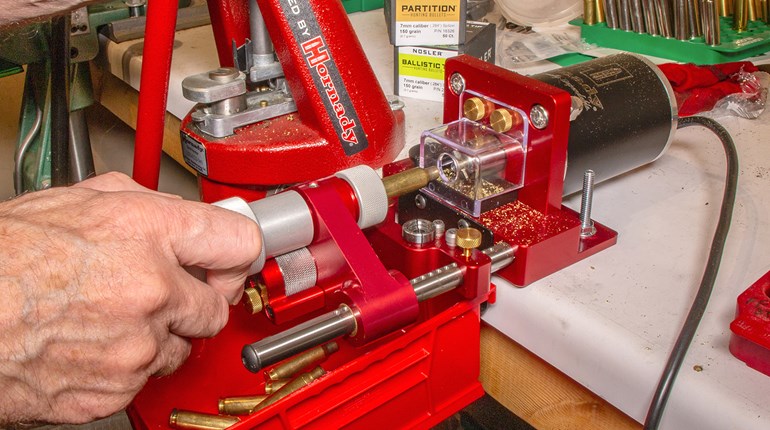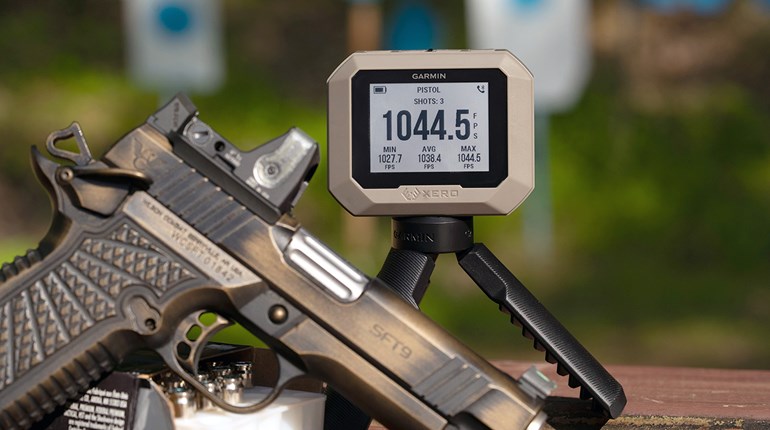
Winchester catalogs two dozen different loads for the 9 mm, and more than a dozen loaded with what most would call an FMJ bullet. Within this mix you’ll find a varied selection, with bullet weights from 115 to 147 grains. There are also different lines of Winchester ammo to include Winclean, USA (better known informally as “White Box”), as well as small- and large-box 9 mm NATO loads. There is also a brown-box, service-grade load. But, the loads I wanted to focus on here are brands within the Winchester line that you might not know that much about or understand exactly what they are. They include the USA Valor series, the Active Duty series and the USA Forged series.
Winchester USA Valor Series
Offered as a celebration of Winchester’s commitment to American freedom, its USA Valor load for the 9 mm features a 124-grain full-metal-jacket bullet with an advertised velocity of 1,200 fps and 396 ft.-lbs. of muzzle energy. Proceeds from your purchase of this ammunition are used to support Folds of Honor, a nonprofit organization that helps provide educational scholarships to the families of fallen or disabled American service veterans. This ammunition is only sold in semi-loosely packed boxes of 200 rounds for about 47 cents per round.
It’s worth noting that this is 9 mm NATO as opposed to 9 mm Luger ammunition. This can be confusing, so the difference between the two is worth explaining. The 9 mm cartridge is known by various names, with the 9x19 mm designation referencing the cartridge’s dimensions—bullet diameter and case length. The “9 mm Parabellum” name was the cartridge’s original name when it was invented by Georg Luger in 1901. (For what it’s worth, “parabellum” is part of a Latin phrase that when translated means, “if you want peace, prepare for war.”) SAAMI, the standards body for guns and ammunition, gave the cartridge the 9 mm Luger name.
From a physical-dimension standpoint, all of these—including the 9 mm NATO—are exactly the same. The difference between them is in chamber pressures. The maximum average pressure (MAP) rating for standard 9 mm Luger ammunition (established by SAAMI) is 35,000 psi. SAAMI has also set the MAP for 9 mm Luger +P ammo at 38,500 psi. The pressures for 9 mm NATO ammo are higher than the SAAMI standard and can, on an individual cartridge basis, be even higher than 9 mm Luger +P ammo. With 9 mm NATO ammo, the bullet weight can range between 108 and 128 grains, and the muzzle energy between 400 and 600 ft.-lbs. But, NATO muzzle energy calculations are based on a 7.85-inch barrel, so you’ll not likely see NATO energy levels out of your carry gun.
Winchester Active Duty
Winchester developed this load to serve the U.S. Army and its new Modular Handgun System (MHS). This ammunition is loaded with a 115-grain FMJ flat-point bullet and is listed as “ball” on the packaging. This is also loaded to 9 mm NATO specs with an advertised muzzle velocity of 1,320 fps, which would deliver an impressive 445 ft.-lbs. of energy at the muzzle. Just as with the Winchester USA Valor 9 mm ammunition, Active Duty ammunition is loaded in reloadable brass cases. It is sold in boxes of 100 and price per cartridge runs about 43 to 48 cents per round.
Winchester USA Forged
The most affordable 9 mm load from Winchester is in its USA Forged line. It is a 9 mm Luger load with a 115-grain bullet. Several things set this load apart from the other two 9 mm NATO Winchester offerings. For starters, this is 9 mm Luger ammunition, so average pressures max out at 35,000 psi. Second, this ammo is loaded in non-reloadable steel cases. Winchester claims these cases have received a proprietary surface treatment to optimize high-volume range sessions. Third, the bullet used in USA Forged ammo is an FMJ, a brass-jacketed, lead-core bullet.
Don’t make the mistake of thinking that this is corrosive ammo just because it is steel cased; it uses a non-corrosive primer and clean-burning powder. This 9 mm load is advertised with a muzzle velocity of 1,190 fps with 362 ft.-lbs. of muzzle energy. This ammunition is offered in 50-, 150-, 500- and 750-round quantities, and it will cost you about 10 cents less per round than either of the two Winchester NATO offerings.
Testing
I thought it would be interesting to compare these three loads by shooting them out of a SIG Sauer P320, which is the civilian version of the Army’s MHS winner, the M17. But, to get a more comprehensive idea of how these loads might perform, I decided to also shoot them out of a compact 9 mm pistol and a short-barreled 9 mm revolver. The chart on page 40 details the actual muzzle velocity and muzzle energy of each load out of each of these test firearms.
External ballistics matter, but reliability is important, too. I fired a total of 500 rounds of these loads out of the three handguns and there were no stoppages of any kind. However, the steel-cased USA Forged ammo was a bit stiff to extract out of the cylinder of the Korth revolver. Also important is precision on target. Shooting off-hand at 5 yards, I was able to punch a ragged hole with each load. I did the same at 10 yards while shooting from a sandbag rest. What I found interesting was that all three loads, out of all three handguns, had the exact point-of-impact at both distances. In fact, I fired a single-hole, 15-shot group at 10 yards from a sandbag rest with the SIG P320 using five rounds of each load.
In short, these are three fantastic 9 mm FMJ loads from Winchester. They should be reliable and accurate from any handgun from which you might shoot them. And now, when you see them on the shelf, you’ll have a better idea of exactly what these loads are and how they might perform.




































